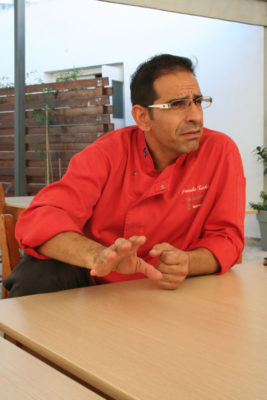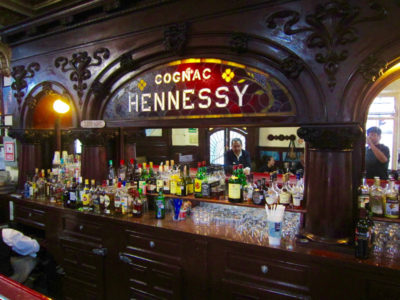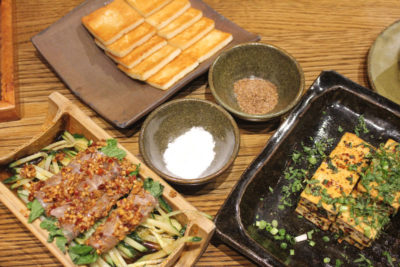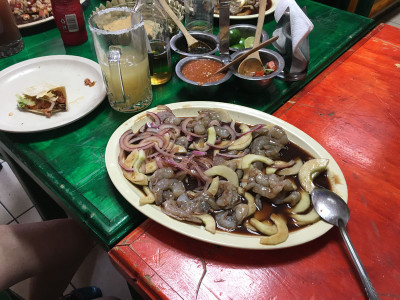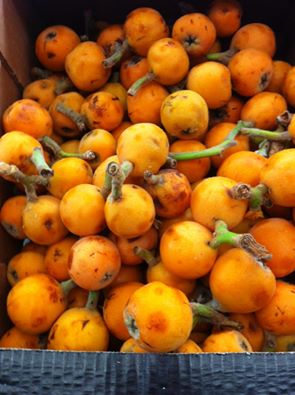We can't find the internet
Attempting to reconnect
Something went wrong!
Hang in there while we get back on track
Search results for
Athens
Summer Picnics: Alfresco in Athens
Athens, unofficially known as the Big Olive, has many delightful spots for a picnic in all seasons. Okay, in summer perhaps you’d rather be on the beach – and that can be arranged if you hop on a bus or tram for the southern coastal suburbs of Voula, Vouliagmeni and Varkiza – but in the city proper you can spread your meal on a hillside with a view of the Acropolis. With the weather often sunny and mild even in February, all you need is a little DIY initiative and the ability to resist the temptation of a snack at one of the many “fastfoodadika” or a sit-down meal in an air-conditioned taverna.
Read moreTokyo
Natsu no Shun: Summer Eating in Tokyo
After the merriment of sakura cherry blossoms has faded, bringing with it the dreary Japanese rainy season, the hot, humid days of July and August follow shortly thereafter. When summer temperatures and the humidity reach a point of sticky and awful, Japanese people tend to change their diet so as to shake off natsubate, the physical fatigue of summer. In a country where the main religion is nature-worshipping Shinto, most people practice the custom of shun: celebrating nature’s cycles and each season’s profusion of food. Loosely translated, “shun” means the height of nature’s abundance. Each of Japan’s fruits, vegetables and also animal proteins has its own shun, and in the essential and enduring wisdom of Japanese cuisine, that has influenced the preparation of Japanese food for thousands of years.
Read moreLisbon
Summer Picnics: Lisbon's Ribeira das Naus
Summertime in Lisbon can mean some very hot days, making locations that get a cool Atlantic breeze at the end of the afternoon ideal for throwing down a blanket. One such perfect spot for a picnic in Lisbon is the new promenade along the Tagus River, located between Praça do Comercio and Cais do Sodré. Ribeira das Naus, formerly part of the docklands where ships were built, was renewed in 2014 as part of the redevelopment plan for the central waterfront, transforming the historic quay into a large public space with a pedestrian walkway and aligning park. On the large steps that hug the water, you can also watch the sunset over the April 25 Bridge.
Read moreWorldwide
Queens' Street Carts of Desire: Saboroso de Aracataca
"Me siento latinoamericano de cualquier país, pero sin renunciar nunca a la nostalgia de mi tierra: Aracataca…” “I feel Latin American from any country, but without renouncing the nostalgia for my land: Aracataca…” ~Gabriel Garcia Marquez Most are animated, some waver and occasionally one stumbles. Every few feet, a door swings open and a bolero, salsa or merengue tune blares from within. It’s Saturday night in Jackson Heights, and up and down Roosevelt Avenue families flow, children beg their parents for sweets, young women gossip and others hop from bar to bar. In the midst of the hustle and bustle works Luis Alfonso Marin, a Colombian immigrant who sells butter-laden, mozzarella-stuffed arepas topped with grated white cheese from his cart at the corner of Roosevelt Avenue and 80th Street.
Read moreShanghai
Ask CB: Shanghai's Summertime Superfruit?
Dear Culinary Backstreets, I keep hearing buzz about “yangmei” season in Shanghai. What’s all the fuss about this fruit? What’s in a name? Shakespeare could just as easily have written, “A yángméi (杨梅) by any other name would taste as sweet.” This little red Asian fruit has a plethora of monikers: Myrica rubra, Chinese bayberry, yamamomo, Japanese bayberry, red bayberry and waxberry. But a decade ago, the sweet and sour fruit was rebranded as the yumberry in the United States (where it is sold in juice and powder form, but not fresh, due to an import ban on the live fruit) to stand out from other exotic “superfoods.”
Read moreRio
Market Watch: Rio's Feira da Glória
Glória is a crossroads of Rio de Janeiro. It’s where the beach and bayside South Zone end before you hit the historical and commercial Centro. It’s home to the storied, luxurious Hotel Glória and the working-class favela Santo Amaro, a five-minute jog away through lines of rifle-armed soldiers meant to keep crack users at bay. There’s the state archdiocese by day, and by night, a red-light zone for legally operating transvestite prostitutes. It comes as no surprise then that Glória’s weekly feira is one of the city’s most authentic and most colorful street markets. Like the vendors on foot on Rio’s beaches, would-be restauranteurs experiment at the feira before spreading their wings on the wider urban gastronomical scene.
Read moreAthens
The Fruit of Greece's Summer: Watermelon in Athens' Central Market
If Greek summer was a fruit, it would definitely be a watermelon. These are baby watermelons from Crete sold at the Athens municipal market. Many taverns will serve watermelon as a desert treat during the summertime. Bonus tip: some Greeks will also have it with feta cheese on the side.
Read moreElsewhere
Peiragmena: Seasonal Food, Tweaked
There’s something about the produce in Cyprus. The tomatoes taste sweeter, the watermelons juicier and the oranges zestier than any we’ve tasted elsewhere. But the domination of local cuisine by the set meze means you’ll sometimes find yourself plowing through another plate of grilled pork, village salad and chips, thinking, “There has to be another way to cook all of this amazing stuff.” Peiragmena does exactly that. “We want to serve whatever’s in season,” said 43-year-old owner Yiannis Katchis. “We use various cooking methods and combinations of flavors, and every three months we change our menu. This is our philosophy.”
Read moreIstanbul
Simitçi Feridun: May the Simit Be Unbroken
The sound of bombs has become an all too frequent occurrence in Istanbul as of late, and residents of the city's Cihangir neighborhood were spooked as ever when an explosion occurred in a building overlooking the main square early on a recent Sunday morning. Blasts sound no less scary when they are the result of gas leaks. When the smoke cleared, 75-year-old Feridun Yükseltürk was found crushed under the fallen rubble, just steps from the spot where he sold simit from a cart daily for the past six years. The tragedy sent shockwaves through Cihangir, where Feridun was a beloved figure renowned for his unwavering generosity.
Read moreRio
Cool Cariocas: The Best Ice Cream in Rio
Carioca summer culture is dictated by the heat. It’s courteous to ask guests if they’d like to take a quick shower upon arriving at your home (because everyone takes multiple showers a day in the summer). Beer at parties must be estupidamente gelado. Movie theaters sell out even for so-so films because the air conditioning inside is delícia. This year, the Rio city government took the bold step of legalizing the use of knee-length shorts for city employees and bus drivers during the summer. Four other critical ways that locals chill out are: sorvete (traditional ice cream), picolé (popsicles), gelato and sacolé (anything frozen in a plastic sack).
Read moreLisbon
Drinking Lisbon's Traditional Liqueur
Veteran bartender Abílio Coelho pours shots of Lisbon's traditional liqueur, the sour cherry-based ginjinha. This spirit is a staple of our Culinary Crossroads walk. Read more about Coelho and his poison of choice in our Behind Bars feature! Thanks to Rick Poon for the photo.
Read moreAthens
CB on the Road: In Thessaloniki, Greece's Capital of Eats
Thessaloniki, the capital of Greek Macedonia and the country’s second largest metropolis after Athens, 500 km to the south, is a youth-loving, vibrant city that never sleeps – and always eats. Most locals here are friendly, laid-back, natural-born foodies who love going out and enjoying good wine and tsipouro. It’s a city with a very long history of culinary hospitality. Founded by King Cassandros in 315 BC and named after Thessalonike, his wife – half-sister of Alexander The Great – it’s referred to by Greeks as symprotevousa, “co-capital,” because of its historical status as a co-reigning city of the Byzantine Empire, along with Constantinople. In 1492 the city welcomed a large number of Jews expelled from the Iberian Peninsula.
Read moreTokyo
Nihonbashi Maishi: A Finer Shade of Tuna
Nakaochi appears to be a chopped-up mound of Japanese tuna, but it isn’t. It looks like it should be an inexpensive cut of fish, but it’s not. Instead it’s a rare delicacy, a one-of–a-kind culinary experience we can’t get enough of. Nihonbashi Maishi looks like just another restaurant grouped in the basement compound of the Tokyo Nihombashi Tower, but it isn’t. It appears to be an ultra-expensive establishment, but at lunchtime it’s not. It’s a favorite go-to place for true aficionados of Edo-mae sushi and nakaochi. Edo-mae sushi is considered the root of all sushi.
Read moreMexico City
Building Blocks: Weeds and Edibles in Mexico City
“I’m a vegetarian – what will I eat in Mexico other than beans and rice?” Taco-madness has so consumed the world’s view of Mexican cuisine that the traditional mainstays of the diet often don’t get the billing they deserve. Beans, corn, squash, chilies and tomatoes are grown together in milpa farms – a biodynamic system of agriculture. Anyone who has ever grown anything knows: if you let a garden grow naturally, you’ll have an abundance of leafy greens that most of us call “weeds.” Well, in Mexico, nothing edible goes to waste. Just as every bit of meat from an animal is used, so are those weeds and all the other tender leafy bits.
Read moreMexico City
Behind Bars: The Ghosts of Drinkers Past at Tío Pepe
For every level of society inside and outside Mexico, cantinas serve as both toxin and tonic for drink, song, jocularity, wit, mayhem and mishap. Tio Pepe, now thought to be the oldest such bar in the old Aztec capital, has provided both in equal measure since way before it received its present name in 1878. The cantina is nowadays a refuge for Mexican politicians, as the nation’s state department and the city’s supreme court sit in front of it. On a Tuesday at noon, we found a huddle of operatives gathered in a booth arguing amid cocktails.
Read moreLisbon
Behind Bars: Ginja Sem Rival's Ginjinha Whisperer
Abílio Coelho is a generous man, offering a smile to every customer while serving each of them the most traditional drink in Lisbon: ginjinha. He has spent 44 of his 63 years behind a counter serving the libation. Ginja Sem Rival, the bar he serves it in, like the best places, is a hole-in-the-wall, and the drink is made in-house. Ginja is the actual name of the liqueur, which is made from a sour cherry of the same name. The fruit might not be so sweet but is fortunately well suited to being turned into this smooth drink, which is enjoyed both as an aperitif and digestif.
Read moreBarcelona
Behind Bars: History, in Bulk, at La Bodega d'en Rafel
When Edu, owner of the Barcelona wine bar Celler Cal Marino, was growing up in the 1980s in the neighborhood of Sant Antoni, he would confuse Rafel Jordana with the iconic German soccer player and coach Bern Schuster (“Schuster is in the bar, daddy!”). Jordana, owner of the bodega that bears his name, is not so famous internationally, but he is undoubtedly one of the icons of Sant Antoni and of the old-school bodega-bar culture in Barcelona. La Bodega d’en Rafel has served as a location for a number of films and television series (such as “Cites,” the Catalan version of “Dates”), a subject of many articles and profiles and an important touchstone for a larger community that connects Barcelona locals with their identity.
Read moreTokyo
Behind Bars: Getting Tight at Tokyo's Tight Bar
If it weren’t for the dozens of brightly lit signs and paper lanterns promising libations of every sort, you might mistake the two narrow alleys alongside the train tracks on the northeast side of Shibuya station for a derelict apartment block. In reality Nonbei Yokocho (AKA Drunkard’s Alley) is one of Tokyo’s few remaining yokocho (side street) bar districts. Like the much larger and better-known Golden Gai in Shinjuku, Nonbei Yokocho is a collection of aging and tightly packed microbars. Each watering hole is scarcely more than a few square meters, and if longtime regulars aren’t taking up the scant floor space, newcomers may try any number of doors before they find an empty seat.
Read moreIstanbul
Behind Bars: Terminal Nostalgia at Mythos
In Istanbul's iconic Haydarpaşa train terminal, the door of a crowded restaurant and bar opens to beams of sparkling light streaming across the Marmara Sea coast. Trains haven't departed Haydarpaşa for nearly three years while the station undergoes extensive renovations, but its restaurant, Mythos, is still open and popular as ever, a refuge for a faithful crowd of regulars, who come to drink at a train station even though they aren’t going anywhere. Built in the first decade of the 20th century by the Germans and gifted to Sultan Abdülhamid II, the station is a handsome and prominent icon of the city, an imposing presence on the city's Anatolian shoreline.
Read moreTbilisi
Behind Bars: For Love of God and Chacha at Wine of Kardenakhi
It is 9 p.m. and we are packing our bags for a red-eye flight to Poland when I realize we have no chacha, Georgia’s otherworldly elixir of distilled fermented grape pulp. We never, ever travel without chacha, and there is no way we’re going to buy over-the-counter, factory-produced product – and not because it’s over-priced. Chacha is a potion brewed by the hands of masters over wood fires in hammer-battered stills sealed in a paste of dirt and ash. Without the human touch – the artistry – chacha is just a soulless, liver-grinding liquor. I make the call. Andria deals in wine, chacha and religion from a devilish little cellar in Tbilisi’s old neighborhood of Sololaki.
Read moreTokyo
Ichiba no Chubo: Tsukiji Market Special
The warren of streets surrounding the current Tsukiji Market – Tokyo’s main wholesale market – are filled with sushi joints, ramen stands, coffee shops and assorted other restaurants tucked between the stalls and knife makers. Walking around during morning hours one could often wonder where the people who work inside the market have their meals. The gentrification of Tsukiji has brought such an influx of tourists that the early market is now closed to outsiders. Visitors are limited to the outer parts of the market and the food stands. Restaurants are jammed. Beginning at 3 a.m. workers drift into the heart of the market and begin to set up for the 5:30 a.m. tuna auction.
Read moreShanghai
Taoyuan Village: Special (Breakfast) Forces
When the nationalist Kuomintang army retreated to Taiwan in 1949 after losing to Mao’s communist forces, the island experienced a sudden influx of immigrants from around Mainland China, many ripped from their homeland and moved into crowded, hastily-assembled housing complexes. These gave rise to tenement communities, called military villages (眷村, juàncūn). During the years after the war, these new immigrants kept the memory of their hometowns alive, recreating the dishes of their childhood but – out of necessity – using local ingredients and adapting the recipes. Out of this homesickness arose a new type of Taiwanese cooking called Military Village Cuisine.
Read moreBarcelona
Santa Gula: Blessed Are the Gluttons
Halfway between a French bistro, a Nordic café and a Spanish casa de comidas (a traditional small family-run eatery where the menu changes according to season and the market), Santa Gula is the perfect place to sin – gastronomically speaking – in Gràcia. Hidden in a small and peaceful square, Santa Gula, or Saint Gluttony, is truly heaven amid Avinguda Diagonal’s commercial buzz. This cozy restaurant with its wonderful outdoor terrace (set up in spring and summer) is without a doubt one of the neighborhood’s best well-kept secrets, attracting a crowd of faithful customers, from locals and area office workers to foodies from across the city.
Read moreMexico City
CB on the Road: Eating Mérida
Mexico’s Yucatán Peninsula was home to some of the most important Maya cities during pre-Hispanic times. One can still get a glimpse the glory of those cities in ruins such as at Chichen Itza, considered one of the seven wonders of the modern world. On the ruins of a smaller Mayan city, T’ho, the Spanish conquistadors founded Mérida in 1542; since then, the city has been the economic, cultural and gastronomic center of the Yucatán Peninsula. We visited the city recently and fell in love immediately. Thanks to its proximity to the harbor of Puerto Progreso and the importance of the henequen industry – which turned the fibers of a native agave plant into rope – Merida’s culture, economy and architecture grew dazzlingly from the 19th through the early 20th century.
Read moreLisbon
Marisqueira O Palácio: Other Fish in the Sea
June is probably Lisbon’s most euphoric month, due to the city’s biggest street party that celebrates the patron Saint Anthony. Though the festival officially takes place on June 12-13, the party runs all month long, especially in Alfama, Mouraria and Graça. The smoke of sardines grilling, colorful decorations, makeshift neon fairgrounds and pimba music blaring from outdoor speakers enliven the narrow roads of these traditional neighborhoods. The bedlam isn’t for everyone, however, and for those who want to find a quieter spot that still celebrates fresh, seasonal fish, Largo de Alcântara is a good alternative. Located in the western part of the city, between Santos and Belém, this zone is a concentration of cervejarias and marisqueiras.
Read moreShanghai
In & Out: No Burgers Here
In & Out arrived in Beijing years ago to rave reviews, but the Yunnan restaurant only just settled in Shanghai, confusing homesick Californians with its name. Instead of Double-Double burgers and Animal-Style fries, it serves cross-the-bridge noodles (过桥米线, guòqiáo mǐxiàn) and fried potato balls (土豆球, tǔdòu qiú). While most Yunnan restaurants in China span the whole province’s cuisine, from tea leaf salads to crispy adzuki beans, In & Out’s menu is (mostly) specific to Lijiang, a city deemed a UNESCO heritage site that lies about halfway between Shangri-La and Kunming, the provincial capital, and is home to the Naxi and several other ethnic minorities
Read moreIstanbul
Around Kumkapı – and the World – in a Day
In Istanbul, there is a single neighborhood where one can find Uzbek mantı, imported Ethiopian spices and hair products, smuggled Armenian brandy, Syrian schwarma and sizzling kebap grilled up by an usta hailing from southeast Turkey’s Diyarbakır. Kumkapı – a shabby seaside strip of century-old homes, Greek and Armenian churches and residents from a vast array of countries that most Americans couldn't pick out on a map – is far and away the most diverse place in Istanbul. Nowhere else comes close. In perpetual motion, Kumkapı is home to a rotating cast of eclectic restaurants that cannot be found anywhere else in the city. Many of these open and close before we can squeeze in a second visit.
Read moreRio
Quetzal: When Life Gives You Cacao Beans
As an electrician in the Galeão international airport, Emerson Gama responded to emergencies like exploding transformers. But in his spare time, he was becoming a self-made expert on Latin American mythology, tropical ecology and sustainable resource management. These passions led him to quit his job four years ago; since then, Gama has become the Rio de Janeiro chocolatier with the most dedicated cult following. Only a few South Zone specialty stores carry his Quetzal chocolates, and where they come from is largely unknown, both to the clients on the long waiting lists for deliveries and to Gama’s own neighbors. The “secret” source?
Read moreAthens
Kollias: Butcher Block to Table
As one approaches the central square of Kalyvia, a small village only 10 minutes from Athens International Airport, the irresistible smell of grilled meat fills the nostrils. The whole area is packed with traditional grill houses, and many Athenians will make the 45-minute drive just to enjoy a meal there. The oldest taverna and one of the most famous is Kollias, which still boasts the traditional butcher shop that gives these grill houses their Greek name (hasapotaverna, or “butcher taverna”). Anastasios Kollias opened the place in 1930 just up the road, but it gradually became too small to accommodate the growing clientele, so it took its current spot on the square in 1991.
Read moreIstanbul
First Stop: Somer Sivrioglu's Istanbul
Editor's note: In the latest installment of our recurring feature, First Stop, we asked chef Somer Sivrioglu of the Sydney restaurant Efendy where he stops first for food when he returns to his hometown of Istanbul. Sivrioglu is the author of the cookbook Anatolia: Adventures in Turkish Cooking (Murdoch Books, April 2016). Any list is controversial and biased by its nature, and lists do not get any more biased than mine, as I am a Kadıköy fanatic and impossible to convince that there are better versions of food on the European side of Istanbul. I was born and raised in Kadıköy, and we lived first at Caferağa, five minutes to Kadıköy market, then in Moda, Kalamış and Fenerbahçe.
Read moreRio
Pizzaria do Chico: (Not So) Humble Pie
When they come into this shoebox of a pizzeria that still looks like the pé sujo (“dirty foot”) bar it previously was, clients often ask: But where’s Chico? That’s because they’re expecting Santa Teresa’s most beloved pizza chef to be a rotund and cherry-cheeked grandfatherly figure, perhaps in a red or green apron to make the point hit home. The toothy-grinning and somewhat lanky real Chico is instead someone who likes wearing running shoes to work so he can sprint out of his kitchen to greet the passersby on this cobblestone street for which he feels such affection he turned down a proposal to move to California. (More on that later. It involves Sylvester Stallone.)
Read moreAthens
CB on the Road: Crete's Wines of Old, Made New
Crete, Greece’s largest island, is among the country’s most beautiful and interesting places to visit. Well known for its amazing beaches and unforgettable cuisine, the island also has a long history of wine making, dating back more than 4,000 years. The ancient Minoan civilization was one of the first to be deeply connected with wine. Viticulture and wine making are depicted on paintings in the Minoan palace of Knossos, while ancient wine presses have been found all over the island, with the world’s oldest in Vathypetro, just a few kilometers outside Heraklion, the capital. The Minoans were the world’s best-known merchants of the time, and amphorae carrying Cretan wine have been found in digs all over the Mediterranean basin.
Read moreIstanbul
Let Them Eat Lettuce: Reviving an Endangered Urban Green
When you think about lettuce, if you think about it at all, it’s probably as the bland but virtuous base to a salad. But in days past in Turkey, this leafy green was just as often consumed as a snack in itself, as an essential part of a main dish or even as a sweet treat. “Marul [romaine] has been cooked as a vegetable since ancient Greek, Roman, and Byzantine times,” says food writer Aylın Öney Tan. “In many parts of Anatolia, it was a spring tradition to dip marul in pekmez (molasses) or honey, to eat it with something sweet that contrasted with the lettuce’s bitterness.” This wouldn’t really work with supermarket iceberg, of course – to fully enjoy lettuce’s culinary potential requires a fresh, high-quality crop.
Read moreMexico City
Los Sinaloenses: Fish Cartel
The northwestern Mexican state of Sinaloa is nestled between the western Sierra Madre Mountains and the Gulf of California – putting it between surf and high desert, and the sea doth offer bounty. Be it gigantic squid, run-of-the-mill “fish” or marlin, the sinaloenses fear not the chopping block when it comes to seafood, and the state’s devil-may-care attitude (cooking with lime instead of actual heat) comes full force at Los Sinaloenses, located in trendy Roma Sur. The scrappy refuge lights onto a seafood-based, regional cuisine that manages to stand out in a nation with more than 9 km of coastline. It’s characterized by an array of ceviches, cocktails and other arthropod and piscine specialties.
Read moreIstanbul
Al Ahdab: Groceries for the Homesick
On a recent sunny afternoon at the tiny Al Ahdab market, a wedge of light slashed through the front windows illuminating posters for condensed milk in Arabic script and one of an energy drink called Hell. The shop is easy to miss, tucked under the slope of Sarı Musa Sokak, which dips quickly from Millet Caddesi – the arterial avenue home to Istanbul’s Little Syria. By the front door was a rack of Cow Brand ghee, in large tin cans stacked like motor oil at a gas station. Entering the shop we were met with a complex layer of scents. By the drawers along the wall a fragrant cloud of spice hung – cumin, coriander, cinnamon
Read moreLisbon
Taberna da Rua das Flores: Lost & Found
Lisbon’s tiny Taberna da Rua das Flores is almost always crowded, with barely enough room for staff to explain (and often translate) to hungry clients the dishes chalked up on its only blackboard menu. With around 10 marble-topped tables in a narrow, vintage-style eatery that takes no reservations, its small scale and increasing popularity makes for a challenging place to serve food – and yet, the staff are always smiling. The restaurant’s original, contemporary take on the forgotten tavern fare of the city, as well as its patient service and shared love of local ingredients, make it well worth the waiting time.
Read moreRio
Bar do Momo: Soul Pub
At Bar do Momo in Tijuca, there are many things to celebrate, but the two dishes starring jiló are particularly magnificent – and show how this little gastropub punches well above its weight. A green, meaty, slightly bitter cross between an eggplant and a pepper, jiló was brought to Brazil from West Africa during the slave trade. At Bar do Momo, the vegetable is served two ways: One is the jiló recheado, not unlike a chile relleno, stuffed with beef and mozzarella cheese that melts into a savory broth. The other is the only Brazilian guacamole worth your time: made from tangy pickled jiló, red onion, tomato, lime, cilantro, and Brazilian dedo de moça pepper.
Read moreShanghai
Yi Zhang Hong: Feel the Burn
Healthy eating and Chinese food are often hard to combine, but Karen Chen has discovered the recipe. After the success of Jianguo 328 (a homestyle Shanghainese restaurant that forgoes MSG and uses filtered water to boil its excellent noodles), the Taiwanese restaurateur decided to look west – where spice is king – for her next venture: Yi Zhang Hong. The friendly Sichuan restaurant is cobbled together with a narrow staircase leading up to cheerful dining rooms over three floors. On each level, bright folk art hangs on white walls above long banquettes and blond wood tables, and the red-tiled bar on the first floor is decorated with bottles of imported wine and beer and canisters of local tea.
Read moreIstanbul
Can Ocakbaşı: Closer to the Hearth
Istanbul’s Aksaray district is a difficult place to get to know. It's probably the most diverse district in all of Turkey and with a very high turnover rate. Those Georgian ladies you saw dragging an overstuffed plaid duffel down Buyuk Langa Caddesi yesterday? They might be halfway to Batumi by now. The Syrian family by the bus stop? They may be on their way to meet a man in Izmir about a boat. Who knows? Aksaray’s unknowableness makes some locals uneasy; there's got to be mischief in all that motion, with all of those foreigners. Such is the stigma of Aksaray, den of thieves.
Read moreTbilisi
Tbilisi Sketches: Dining with the Dead
It’s a mid-week spring day in Tbilisi and we have joined Dali Berdzenishvili and her family for a special picnic lunch. There’s a zesty looking spread covering most of a yellow and blue tablecloth: heaps of khachapuri (cheese bread), blinchiki (meat rolls), sliced meats and sulguni cheese, salads, a trademark Georgian dish of pickled greens known as jonjoli, a bowl of strawberries and a few slices of leftover Easter paska cake. For drinks, there are several bottles of semi-sweet red and a bottle of homemade grape juice. Dali says her late husband, Zviad, loved a picnic like this. And it is Zviad who brings them all here – because they are eating next to his grave.
Read moreWorldwide
Queens: The Promised Land, Pt. 3
Rego Park and Forest Hills are home to much of Queens’ Central Asian Jewish diaspora. The neighborhoods comprise two main thoroughfares, 63rd Avenue (which changes to 63rd Street) and 108th Street. Both roads have a range of markets, restaurants and bakeries catering to local tastes. Here are a few notable addresses. Queens Gourmet Bazaar Food Brothers Yusuf and Juda Saz run this long, narrow market that is filled with Persian staples. Mini barrels of nuts, seeds, dried fruits, several Samarkand raisin varieties as well as fruit molasses, barberries, and other provisions in cans and glass jars cover the floor and walls. The brothers make some of the ready-made food in-house.
Read more







